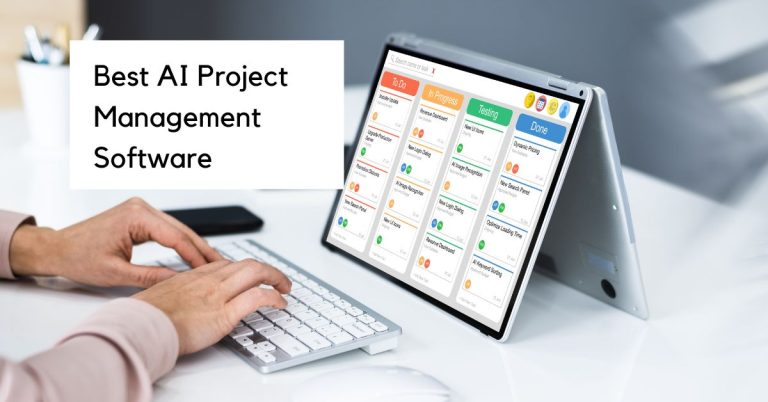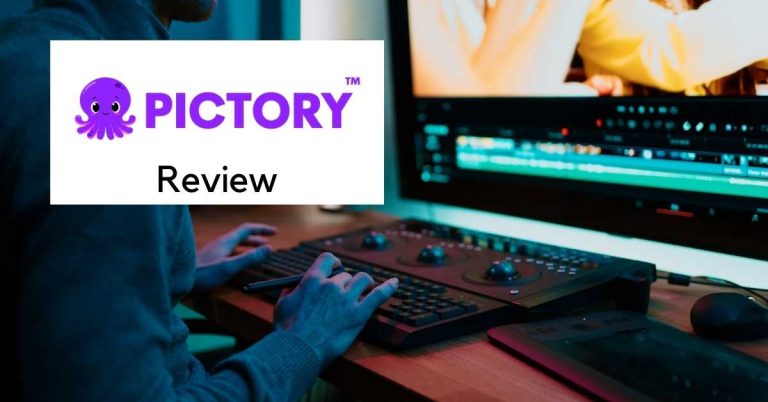Legally AI: The Guide to Legal Excellence
Have you heard about the AI that passed the bar exam? Generative AI has been the talk of the town, not only for their insane scores on standardized tests but also for their capabilities in performing all sorts of tasks.
The question is: are they going to replace some legal professionals, and slowly overtake the legal industry? Will AI replace lawyers? Or are they going to be your own personal intern who drafts legal documents and provides client support? If so, how can you use these trendy generative AI for legal?
In this article, we will explore and elaborate on how you can utilize these new resources to your advantage and be faster and more efficient than ever before.
Understanding Generative AI
With all of the buzzwords the tech guys are using, it can be hard to find simple, common-language explanations of what these generative AI models are and how they work. We dug deep into this topic in our article on foundation models.
What’s important to keep in mind is that generative AI creates new things (text, images, code) based on the patterns they established and learned during their training.
Training and Limitations
In the example of the model ChatGPT, the model was trained by having to read a massive amount of text data. The model then learns how to answer our questions and requests (prompts) in a human-like manner.
What does the data the model was trained on consist of? 85% was web data (everything from blogs to news outlets) and 15% was books of diverse genres, time periods, and authors. And then, it was released to the public. That is why it is important to remember that in the case of ChatGPT, its data is only relevant up to 2021.
If you were to ask ChatGPT about the United States Supreme Court’s decision in Roe v. Wade, it will tell you that it is not in fact overturned (and rightfully warn you that its data is not up to date).
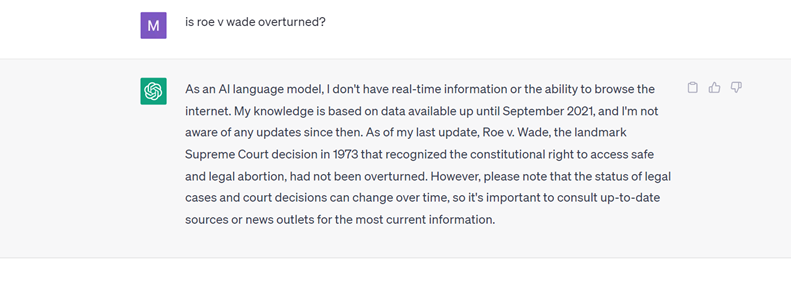
But if you were to ask it to summarize a legal document and save you time, while providing you with key points, it can do it in seconds!
Getting Accurate and Relevant Responses
To make sure you get accurate and relevant results when using AI, consider the following:
- Prompt correctly: The relevancy of the AI’s response lies heavily in the phrasing and context of your prompt.
- Understand generative AI limitations: As explained in the previous section, the models don’t necessarily have real-time data and can have bias. Make sure to fact-check new information with authoritative legal sources and consult legal experts.
- Use reputable AI platforms: Look for platforms that are verified and prioritize accuracy, and transparency and have a track record of delivering reliable results.
- Think critically: Critically evaluate results generated using AI and make sure to consider potential bias and limitations of the model. Generative AI sometimes has hallucinations, meaning they confidently give responses that might not be 100% true.
When using large language models like generative artificial intelligence, keep in mind that AI is a tool that can assist legal professionals, but it should not replace your expertise, experience, and professional judgement. Generative AI tools may not yet be perfect, but with the right guidance and proper use, can help you save a lot of time and resources.
Applications in the Legal Industry
As a legal professional, there are several ways you can use AI to enhance your work. Below we explain how to do exactly that.
Legal Research and Case Analysis
AI-powered platforms for legal research provide quick access to relevant statutes, case law, and legal opinions. These platforms utilize advanced natural language processing (NLP) and machine learning algorithms to analyze vast amounts of legal data and extract key insights.
AI tools can search through extensive databases, identify relevant precedents, and provide comprehensive summaries of legal documents, enabling law professionals to stay updated on the latest legal developments. For instance, Westlaw Edge provides a user-friendly interface for conducting searches, accessing relevant legal materials, and obtaining comprehensive insights.
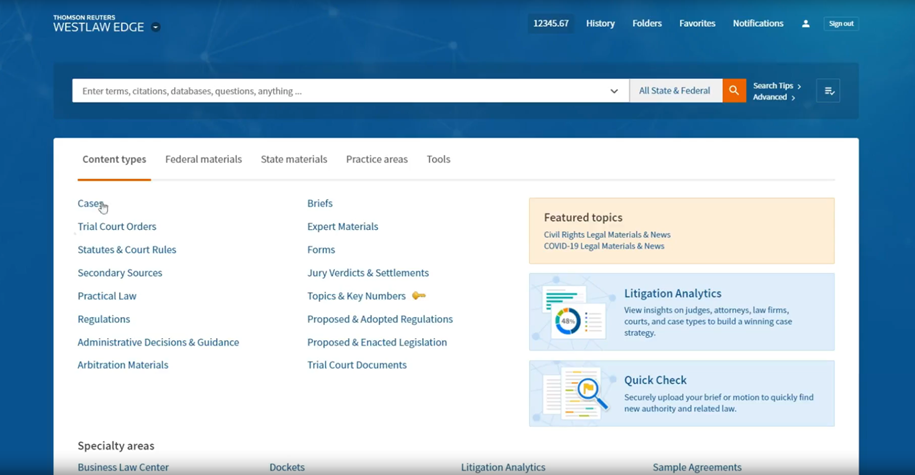
These AI platforms can also assist in case analysis by automatically categorizing and organizing documents, highlighting relevant passages, and identifying patterns and trends. With AI such as Google’s Document AI and Biggle Legal, legal professionals can quickly identify arguments, counterarguments, and potential outcomes, improving the quality and efficiency of their work.
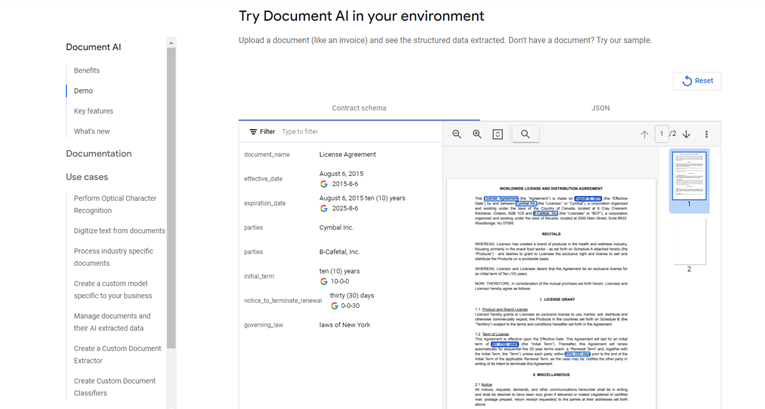
Drafting Legal Documents
AI can generate drafts for various legal instruments, such as contracts, agreements, and pleadings, in a matter of seconds. These AI tools analyze and synthesize information from legal databases and existing templates to provide you with human-like drafts.
With AI you can generate initial drafts that include standard clauses, relevant provisions, and appropriate legal language. However, it’s important to note that these kinds of drafts require careful review and customization by human legal professionals.
There are a number of AI writing tools, but law-specific tools like Ghostwriter, Ghostwriter Legal, and Amto AI can be integrated into existing document creation software, like Microsoft Word, to provide assistance in drafting legal documents. Just click on the Get Add-Ins button in the Insert tab and type the name of your desired tool.
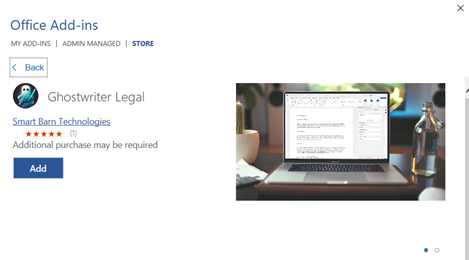
Client Communication and Support for Law Firms
Instead of manually replying to numerous clients’ repetitive questions and emails, you can get an AI tool like One Law to do it for you. AI-powered virtual assistants or chatbots can be integrated into law firm websites or communication platforms to engage with clients, answer frequently asked legal questions, and provide preliminary information.
However, it’s essential to emphasize the importance of human interaction and legal expertise in providing accurate advice. While AI can assist in handling initial client inquiries, complex legal matters still require the involvement of human lawyers to ensure proper understanding, analysis, and advice based on individual circumstances.
Unlocking AI’s Full Potential
In order to get the most out of AI tools, there are a few things you should keep in mind.
Customization and Training
Training the model (giving it more specific data in order to generate more specific results) on large and specific legal datasets can improve accuracy, reliability, and performance. By training the model on large and specific legal datasets, you can fine-tune its understanding of legal concepts, terminology, and nuances. This is why we are witnessing more and more AI tools that have specific use cases relevant to the legal profession. You can get more accurate results using a fine-tuned model than using a model that is broad like ChatGPT.
Crafting the Perfect Prompt
The quality of the AI’s response lies mostly in how you phrase your request (prompt). In our article on prompting, we explained how you can get AIs to do exactly what you want. But here is a summary.
Define the Objectives
Defining the objectives clearly is the key to ensuring that the AI understands what kind of response you want. When you are writing a question or request to the AI, you need to provide clear instructions that align with your specific needs and goals. Let’s say you’re looking to get information about the legal implications of the newly introduced intellectual property rights law.
A good example would be: “Please provide an analysis of the potential legal implications of a recent Supreme Court ruling on intellectual property rights. Here is a recent article about it for context: [Insert a news article about the ruling to provide context]”
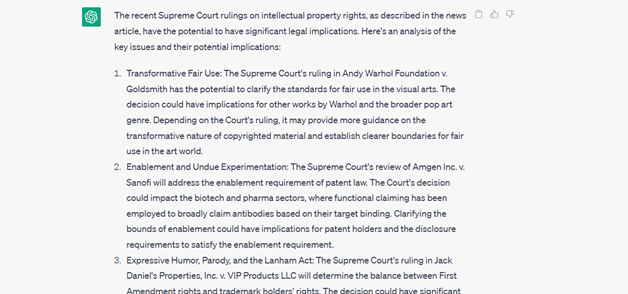
In contrast, here’s a bad example: “Tell me about intellectual property rights.”
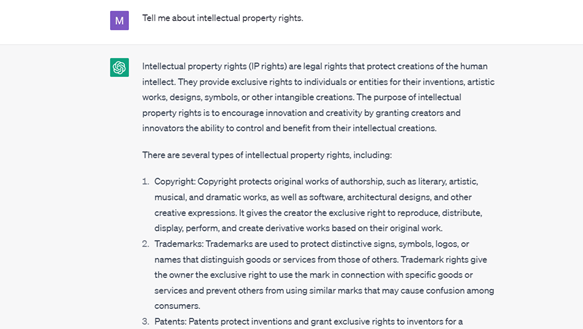
When you clearly define what you want to get out of the response, such as in the good prompt example (defining the objectives and inserting a relevant article as context), you’ll get a response that is much more precise and clear. The model will not have to assume what you want (like with the unclear and vague bad prompt example), and then give you a vague response, that has little to do with your desired response.
Craft Clear and Specific Prompts
In order to avoid ambiguity and make sure the AI focuses on exactly what you want it to do, you’ll need to craft clear and specific prompts. Maybe you’re looking for key things to include in a contract for it to be considered a valid contract.
A good prompt would be: “Identify key elements that must be present to establish a valid contract under contract law.”
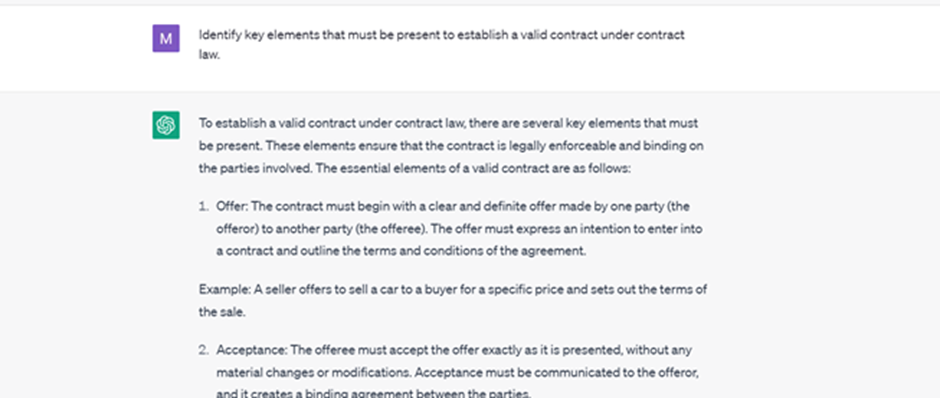
A bad prompt would be: “Explain contract law.”

The more specific and clear you get with your phrasing, like with the good example prompt (where the model was instructed on precisely what to deliver), the happier you’ll be with the initial response. In the example of the good prompt, the model delivered the desired response. In the example of the bad prompt, the model delivered a vague answer, requiring you to ask the model again in order to get the desired answer.
Provide Sufficient Context
Providing sufficient context will help the AI understand the specific circumstances and background information relevant to the prompt and your request. You can make sure about that by attaching relevant documents, articles, emails, etc.
If you are looking into getting a precise and custom-written response to a client email, a good prompt would be: “Write a response to this client email. [insert email] Here are my working hours and my rates [insert hours and rates].”
A bad prompt would be: “Reply to this email. [insert email]”
AI will give you a very vague response if you do not provide it with enough context. It will reply to the email, but it might even reply with the wrong data. But if you give it those few more bits of context, it will do wonders.
Test and Refine Iteratively
Iterative testing and refinement involve experimenting with different prompts and refining them based on the AI’s responses. This process will allow you to improve the accuracy and relevance of the AI’s output over time. Perhaps you are looking into filing a defamation lawsuit and would like to know the likelihood of success.
A good prompt would be: “[Insert documents]. Based on the provided facts and legal precedents, give an opinion on the likelihood of success in a defamation lawsuit against a public figure.”
A bad prompt would be: “Can you provide information about defamation lawsuits?”
But a bad prompt can be a good starting point. You can refine it to: “Can you give an opinion on the likelihood of winning a defamation lawsuit?”
And then, if you are still not happy with the answer, refine it to: “Can you give an opinion on the likelihood of success in a defamation lawsuit against a public figure?”
And finally refine your prompt to give the AI context: “[Insert documents]. Based on the provided facts and legal precedents, give an opinion on the likelihood of success in a defamation lawsuit against a public figure.”
Integration with Legal Tools and Platforms
AI can be integrated into existing legal tools and platforms to enhance your efficiency and workflow by automating routine tasks, improving accuracy, and providing intelligent insights.
Examples of potential integrations include:
- Document Creation Software: AI can be used to summarize, draft, and write legal documents. You can easily install AI add-ons like Ghostwriter and Amto AI to existing document creation software like Microsoft Word.
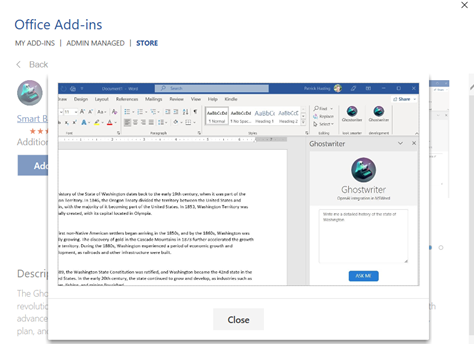
- Document Management Systems: AI can be used to streamline the management of legal documents by automatically organizing, categorizing, and tagging documents based on their content. By automating mundane tasks, not only will you save time, but also reduce the chance of possible mistakes. Australia’s LawSupport already integrated AI into its document management software.
- Legal Research Platforms: AI can augment legal research platforms by analyzing vast amounts of legal data and providing relevant and comprehensive insights. The legal research platform Westlaw Edge already combined comprehensive legal data with AI capabilities to provide automated intelligence for legal professionals.
- Contract Review and Analysis: AI can assist in contract review and analysis by automatically flagging potential issues, inconsistencies, and missing clauses. The software Legaly is a great tool that you can try out for free.
- Due Diligence and Discovery: AI can enhance due diligence and discovery processes by automating the review and analysis of large volumes of documents. Ansarda has already introduced tools that provide insights into bidder motives in a deal and can help predict patterns.
- Legal Analytics: AI-powered legal analytics platforms can provide data-driven insights and predictions to support decision-making.
- Virtual Assistants and Chatbots: AI-powered virtual assistants or chatbots can be integrated into legal tools and platforms and the law firm’s website to provide quick and accurate responses to common legal questions, automate client intake processes, and assist with legal research.
New AI tools that are specifically made for law professionals are emerging on the market every day. These tools can take a lot of workload off your shoulders, and help you automate many tasks.
The Rise of AI Law Tools
Apart from the tools mentioned above, there are a number of AI tools specifically designed for the legal system. Below is a brief overview of the most promising ones. For a more in-depth overview of AI law tools, check out our list of the best AI legal tools.
Lawgeex
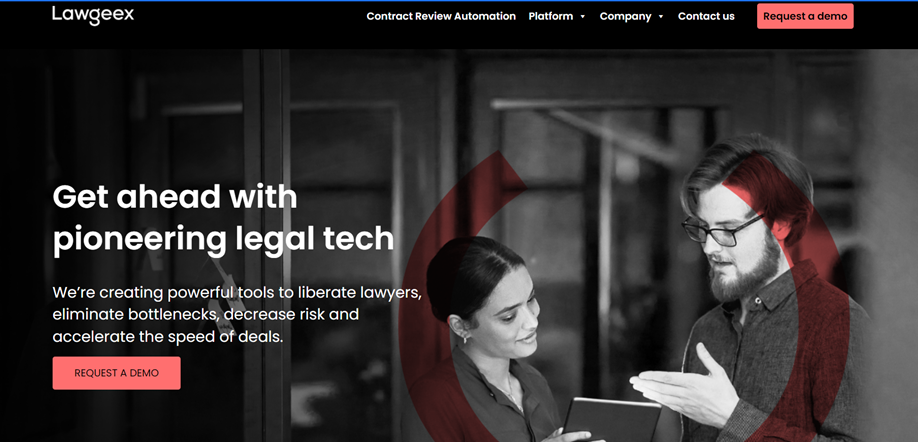
Lawgeex is an automated contract review platform that utilizes AI technology to review and redline legal documents based on predefined policies. It goes beyond flagging missing clauses by understanding the contractual context and user’s position, making redlines, and negotiating with the counterparty. Lawgeex acts as an extension of the legal team, providing consistent contract review in less time and with increased precision. Their solution has demonstrated a high ROI and substantial time savings in contract review and negotiation processes.
CSDisco
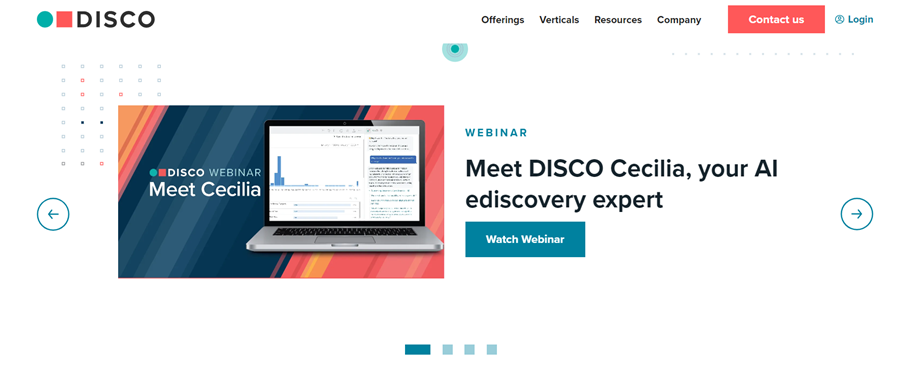
DISCO is a cutting-edge legal technology platform that combines AI-driven software engineering with a deep understanding and respect for the law, streamlining legal processes from start to finish, including request, hold, eDiscovery, review, case building, and professional services, with features such as fast search speeds and sensible pricing, making it a preferred choice among lawyers and legal professionals.
Lex Machina

Lex Machina is a legal analytics software that predicts the behavior of courts, judges, lawyers, and parties. Their platform offers accurate, complete, and transparent analytic data, including exclusive outcome analytics, compiled and enhanced by a combination of machine learning and legal experts. With features like Unique Outcomes, Case List Analyzer, and Quick Tools, Lex Machina enables both individuals and law firms to quickly find relevant cases, compare judges and law firms, and access accurate and comprehensive data in the legal system. Their platform captures and analyzes data from various sources, including PACER and state court data, updating it every 24 hours.
Latch
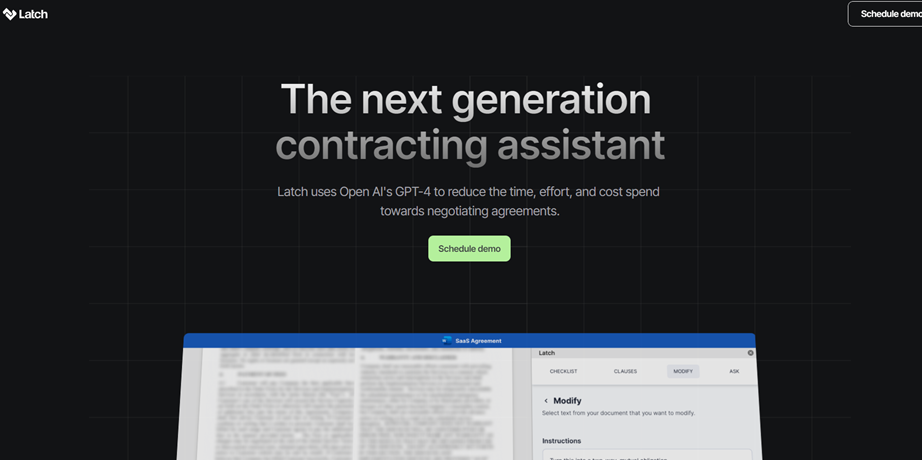
Latch is a next-generation contracting assistant powered by Open AI’s GPT-4. It leverages advanced artificial intelligence capabilities to streamline and expedite the agreement negotiation process, offering features such as generating suggestions, modifying clauses, asking questions, and creating checklists, ultimately saving time and resources for law firms and legal professionals for other kinds of legal work.
OneLaw.ai
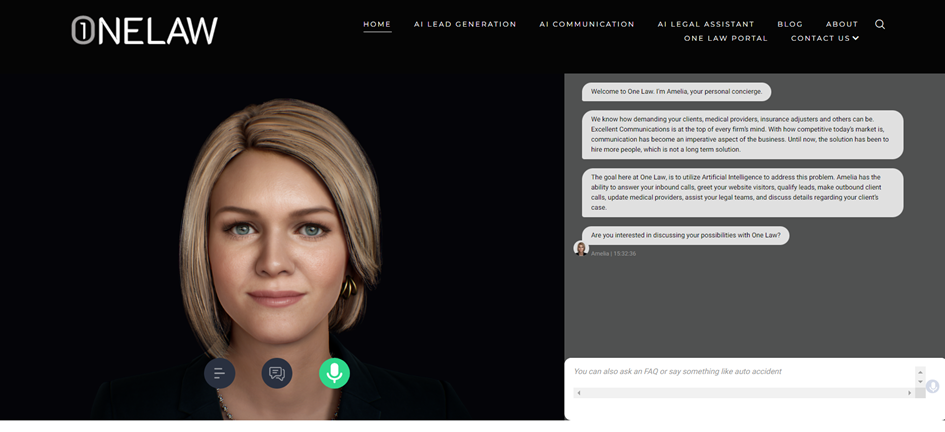
One Law is an AI platform designed to bring artificial intelligence to law firms, offering various legal services, such as AI lead generation, AI communication, and an AI legal assistant. Amelia, the virtual legal assistant, is highly cognitive and conversational, capable of handling various tasks and engaging with clients through multiple channels, ultimately improving efficiency and customer service in the legal industry.
DoNotPay
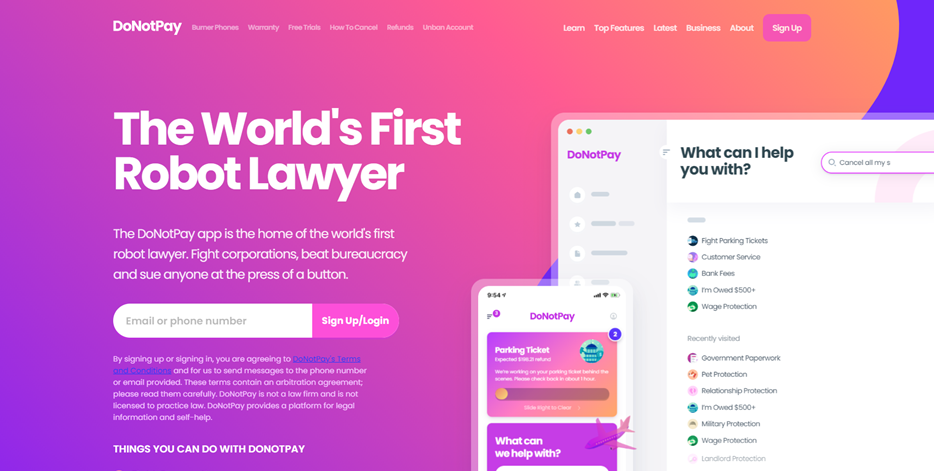
DoNotPay is the world’s first “robot lawyer”. With a wide range of features, including canceling free trials, analyzing terms of service, and filing complaints against companies, DoNotPay provides a platform for legal information and self-help, empowering individuals to tackle various legal and administrative challenges efficiently. This kind of software could prove to help low-income Americans, but it could never replace the legal services of a human lawyer.
Limitations of Generative AI
AI is very much in its infancy phase. Currently, there are a number of limitations to available models, as well as unsolved ethical questions. A step in the right direction when it comes to solving these questions is the fact that The House of Representatives got 40 ChatGPTPlus licenses in order to better understand its use, applications, limitations, and potential problems.
Ethical Considerations
Using AI in the industry has already raised legal ethics concerns such as bias, privacy, and confidentiality. AI tools can perpetuate the biases already present in the training data and lead to discriminatory outcomes towards same-sex couples or POCs. In order to protect client privacy and maintain confidentiality, safeguards must be implemented.
While AI can provide legal advice to a certain extent, and perform certain legal tasks like document drafting and interpreting legal principles, human interpretation, and contextual understanding are essential. An AI tool can assist in writing legal documents, but human supervision is necessary. In contract management, overreliance on AI can result in errors or omissions. Legal issues arise with models like ChatGPT (and tools that are using ChatGPT), as they can provide inaccurate and outdated information, requiring verification and validation. Human oversight and responsibility are crucial when using tools like these, as they cannot replace the judgement of human lawyers.
Accuracy and Reliability
As previously mentioned, generative AI models need to be trained on data before they are released to the public. That means that the data can be irrelevant by the time you get to use the service, potentially leading to chaos. In order to get up-to-date relevant information, we would urge you to consult other sources.
Legal Expertise and the Future of Legal Professionals
Are law firms going to fire all of their interns and use AI to replace them? No.
Are there potential risks of job losses because of AI? Maybe.
Will generative AI tools provide legal assistance? Yes and no. They will help the legal team review contracts and other legal documents and perform in-depth legal analysis, but they will not replace human legal advice.
The future of legal professionals remains firmly rooted in their expertise and the fundamental role they play in interpreting and applying the law. News headlines that predict massive layovers in the legal profession base their reports on the fact that some tasks will be automated. But, not every law firm will be quick to adapt its legal services to a machine-learning system. It will happen slowly, but our advice is, as with all professions, that people who practice law must continue to adapt and evolve their knowledge.
So, will artificial intelligence replace human lawyers and take over human tasks? No.
Final thoughts
The verdict is in: AI is the future of the legal field. Generative AI has been created to be a tool. A tool that can enhance our human potential, not replace it. AI can not provide legal services to humans. A human lawyer can. But a human lawyer, equipped with an AI tool can now achieve more than ever before.

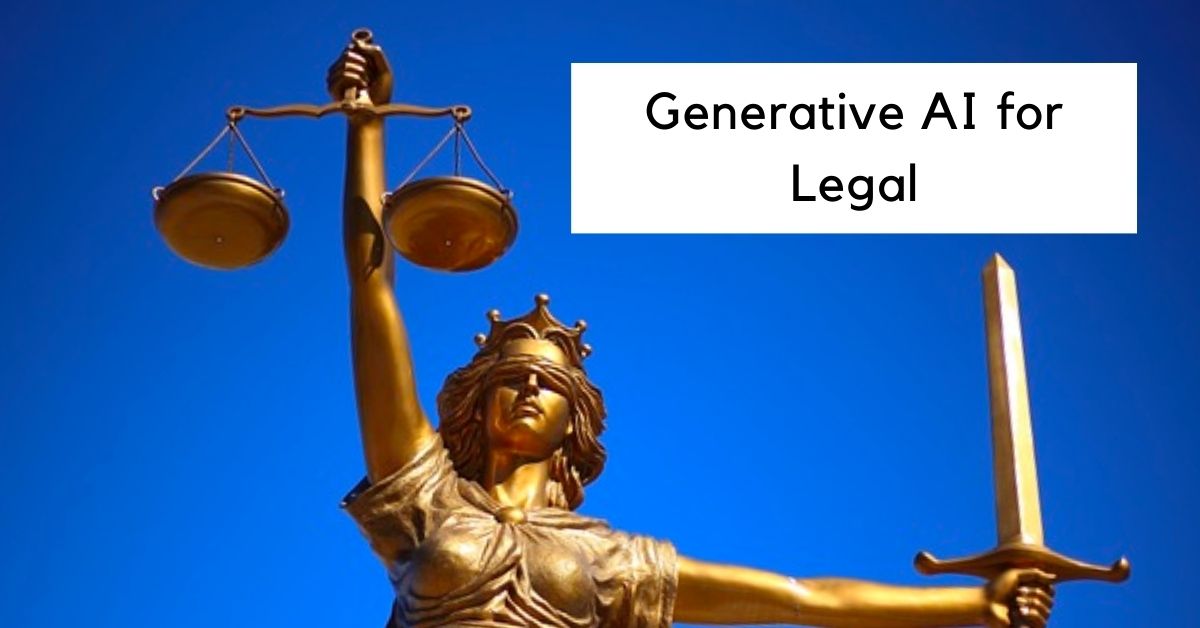

![11 Best AI Art Generators [By Category] of 2024](https://renaissancerachel.com/wp-content/uploads/2023/01/best-ai-art-generators-768x402.jpeg)
